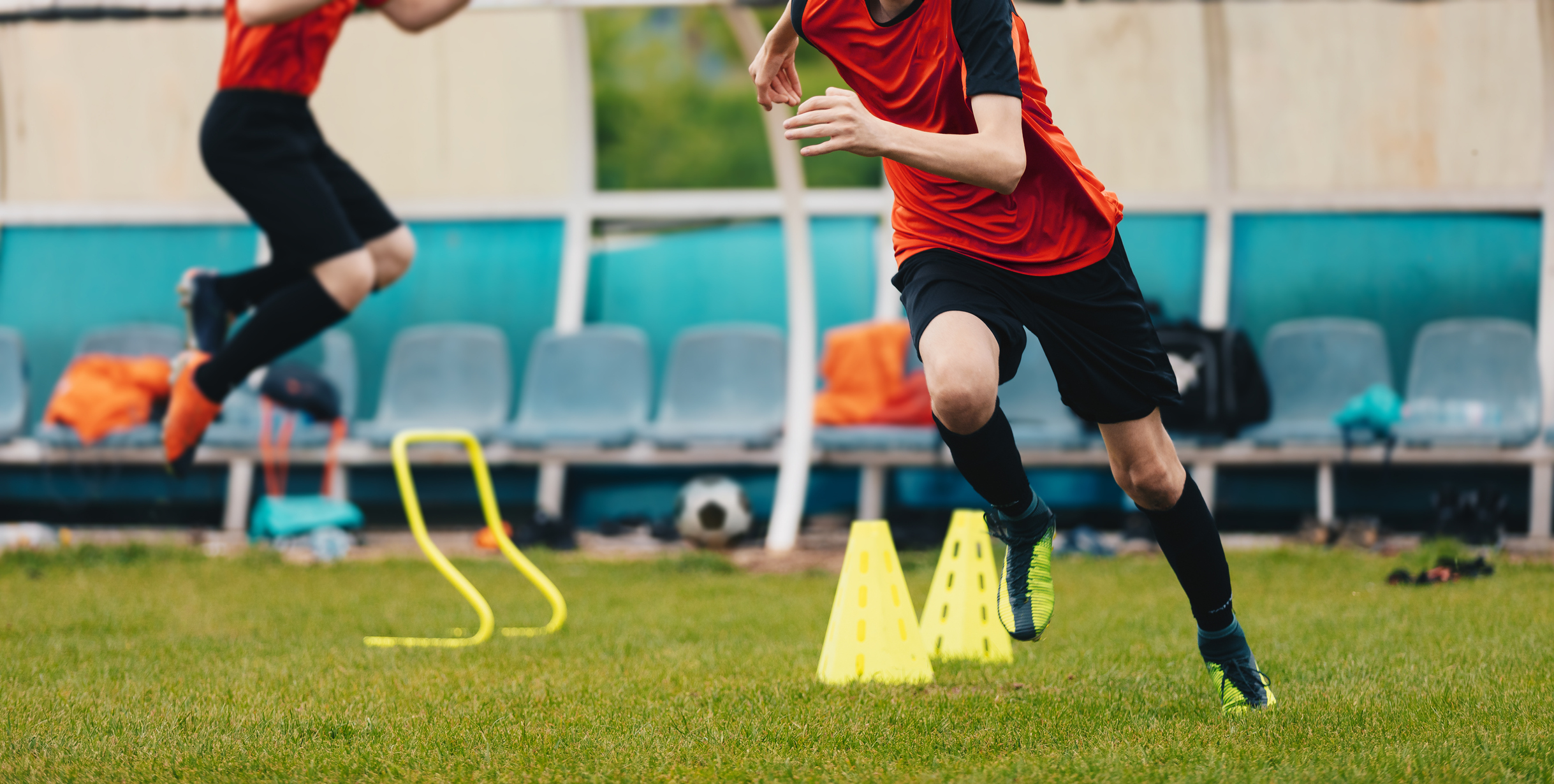
By Dr. John R. Mishock, PT, DPT, DC
Elite-level athletes (football, basketball, baseball, softball, soccer, lacrosse, field hockey, rugby) can quickly read and react to game situations significantly better than novice level players. From a sheer athletic perspective, speed, agility, quickness, and reaction time can separate a good athlete from a great athlete. In my Train 2 Play, sports writings, I use scientifically based training concepts to help coaches, parents, trainers, and healthcare providers teach and create proper physical literacy and athleticism for improved sports performance. The program starts with basic movement patterns, progressing to advanced exercise and elite training techniques. In this program, I will describe a speed and change-of-direction training program that can be done at home with a coach, parent, or experienced athlete.
How much does genetics affect my speed and agility?
Many people believe that athletes are born with speed and quickness, with no ability to improve it with training. “You either have it, or you don’t,” so most athletes spend little time on speed and quickness training. Genetics certainly plays a role in the athlete’s ability to run; however, 30-50% improvements can be gained through a scientifically based training program.
The type of muscle fiber an athlete has is the cornerstone of explosive movement. In the past, there were three muscle types described, type I (slow), type IIA (intermediate), and type IIB (fast). Recent research has shown seven muscle fiber types (from slow to fastest): types I, IC, IIC, IIAC, IIA, IIAB, and IIB
The fast-twitch muscle fiber is essential in generating high force and velocity; however, it can only function for a short time period. These include short periods of strength bursts such as those involved in sprints (all sports), jumping, throwing hard, hitting hard, weightlifting, and other athletic power activities. All individuals have and use each muscle fiber type during sports, however, some have a preponderance of one type muscle versus the next.
Scientists have discovered a variation in a gene called ACTN3 (Alpha-actin-3 R577X polymorphism) “gene for speed.” The ACTN3 gene encodes a protein present in fast-twitch muscle fibers. In the Olympic sprinter, nearly 100% of those athletes have the ACTN3 gene. The gene, AGTR2 gene C allele (gene involved in skeletal muscle development), is associated with an increased proportion of slow‐twitch muscle fiber. Athletes with this gene tend to gravitate and excel in endurance type sports with a high degree of aerobic capacity needed. On the other hand, if an individual had an A allele (AGTR2 gene A allele) for this gene, they would have a higher percentage of fast‐twitch fibers similar to ACTN3.
The study of the human genome is in its infancy, and there are potentially a myriad of other genes that could influence speed but have yet to be discovered. Research has shown that with the appropriate training program, athletes can increase their speed and power independent of their genetics. Now, that individual may not be able to hit a baseball 400 feet or run a sub-9-second 100-meter dash, but they can optimize the genetics for which they are given. One can be a great athlete without the ACTN3 gene; however, they most likely will not be an Olympic sprinter. For the individual who does have ACTN 3, AGTR2 gene A allele, and the possibility of a host of others yet discovered, their potential to make performance gains in power and speed with proper training can still occur.
Can my genetics be changed to improve speed?
Epigenetics is the study of molecular mechanisms by which the environment controls gene activity. Based on epigenetics, 30-50% of muscle fiber type could be explained exclusively by differences in the training. In other words, exercise training can influence muscle fiber type. (This is reviewed in my book “Fundamental Training Principles: Essential Knowledge for Building the Elite Athlete”) Therefore, despite one’s genetics, there is an opportunity to increase fast-twitch muscle through appropriate training.
What is agility?
Agility is the ability to link several fundamental movement skills into a multidirectional movement pattern. In sports, most decisions need to be made in less than 200 milliseconds. The new frontier and athletic development may be the ability to create agility in developing athletes.
The two main attributes of successful agility are the change of direction speed and cognitive function. The cognitive component is the ability to read and react to given stimuli. An example would be a basketball player dribbling against a defender. The offensive player reads the body language of the defender (the cognitive function) and makes a dribble move accelerating to the basket (change of direction speed). Another example would be a tennis player who reads his opponent’s body position, the tennis racket angle, the spin of the ball (the cognitive function), and reacts quickly moving to the hit ball (change of direction speed).
When an athlete is competing, information from sight (eyes), kinesthetic awareness (joints, ligaments, muscles, and tendons), the vestibular system (inner ear) feedback to the brain and nervous system to make fine adjustments to our center of gravity and the appropriate athletic movement. As a result, an electric impulse is sent quickly to the brain for processing and then back to the given muscle to create movement. The athlete sees and feels the activity going on around them during the game or sporting activity. The athlete must promptly make the appropriate change of direction move to make a play. For example, the baseball shortstop knows that the pitch is going to be a curveball. He sees that the batters swing is off balance as he rolls his hands over during the swing. The shortstop begins to move to his right before the ball is hit. The shortstop explodes to the ball with a crossover step and then dives to make the catch.
Agility is a complex neurologic feed-forward and feedback mechanism between the brain and the motor system, which allows the athlete to link the cognition and change of direction activities to make a play during sports. The brain and motor system are in a continual state of feed-forward and feed-back neurological loops during performance and can be enhanced with proper training.
What is “first step” quickness?
Elite-level athletes can quickly move in a wide variety of patterns with speed, efficiency, and control reading and reacting to game situations. Quickness is the ability to explosively initiate movement from stationary or near stationary body position and or changing speeds (shifting gears) during gameplay.
This high level of ability starts with first-step quickness, which at its core, requires proper posture, and specific movement patterns. Without the correct posture and movement pattern, energy is lost (energy leak). The “energy leak” causes movements to be slowed, uncontrolled, and increases musculoskeletal injury potential. Change of direction drills helps to develop this skill.
What is change-of-direction quickness?
Change-of-direction ability requires that the athlete pose; first step quickness, strength, power, acceleration, deceleration, coordination, and balance. The athlete’s ability to accelerate (change in velocity per unit time) or decelerate (decrease speed and or stop from high speed) is often the separator in elite athletic performance. It is essential to be able to slow the body down to then quickly change direction and accelerate into a new movement; backpedal, shuffle, slide step, crossover step, or other movement. Deceleration puts a great deal of stress on joints and is often a source of injury in sports. Therefore, deceleration training may be preventative in helping to reduce sports-related injuries.
Why is movement coordination necessary in change-of-direction?
While the athlete is accelerating and decelerating, the body is being finely controlled. This ability to smoothly control the body and process multiple muscle movements in sequential order is coordination. This coordination of movement optimizes muscle length-tension relationships and provides appropriate bone joint angles to create leverage for momentum.
How does balance affect change-of-direction movement?
The athlete needs great balance to optimize movement and prevent “energy leaks”. There are two critical phases of balance; static and dynamic (functional).
Static Balance Phase
In this phase, the emphasis is placed on developing a stable pelvis. Without a stable pelvis, compensations will occur elsewhere in the kinetic chain (moveable body parts) leading to “energy leaks.” This stable pelvis is created through core (a group of trunk muscles that surround the spine, pelvis, and abdominal viscera) stability. Core stability is essential for proper load balance within the spine, pelvis, and kinetic chain. Core strength and motor control is an integral component of all athletic endeavors.
The principle, “distal mobility (ability to move the limbs), is achieved through proximal stability (ability to keep the torso from moving)” is an essential physical therapy principle. For example, the stability and strength of the base of a crane allows the crane arm to move to lift heavy items. Without the base of core stability, the athletes will be less efficient in first step quickness when trying to accelerate and decelerate during performance leading to “energy leaks”.
Dynamic Balance
Dynamic balance is the ability to maintain control of the body while in motion. Developing dynamic balance allows the athlete to make quick stops and starts explosively. Beyond this, high-level dynamic balance may prevent injury by up to 50%, keeping the ligaments, tendons, and muscles in proper alignment and position during the sport. Balance training can improve speed, power, coordination, skill development, agility, quickness, and reaction time.
What are the key change-of-direction mechanics to optimize speed?
In the ability to change direction, three factors can influence the athlete’s movement success; shoulder sway, low body position, and plant foot angle.
Excessive shoulder sway often causes the athlete to lose balance. For example, an athlete plants the foot quickly to change direction. If they have poor control of the core/torso, the shoulders continue to move laterally, causing the player to be off-balance. The athlete then must recover their balance, thereby leaking energy. The excessive shoulder sway is often a sign of abdominal and hip weakness and or poor motor control. The upper body and shoulders should stay oriented to the play while the lower body disassociates, allowing the hips to open up in the direction of travel.
The second frequent change of direction flaw is getting too vertical or tall when moving. The athlete needs to stay low and crouched as if they were in a “tunnel.” The ankles, knees, and hips are bent and loaded with shoulders forward.
Lastly, a foot plant is essential for the proper transition from deceleration to acceleration. The plant foot angle is intended to provide an optimal base for eccentric (muscle lengthening or negative) control in deceleration and concentric (explosive shortening muscle contraction) force production during the subsequent acceleration or push-off movement. The body’s center of gravity should be inside the foot during the foot plant.
Regardless of whether the movement is a shuffle or crossover, the main points of emphasis stay the same. The athlete must; stay low in the “tunnel”, with the right shoulder position while creating a stable foot plant to control body mass and momentum.
What makes up running sprint speed?
There two determinates of running speed, stride frequency (number of times the foot hit the ground), and stride length (distance between running feet). Furthermore, the more one reduces ground contact while running, the higher the speed. Regardless of an individual’s height, fast people have long and efficient strides. The ability to pick up the feet and put them down fast with long strides equals speed.
There are several ways that stride length and frequency can be increased in the athlete. First of all, increase strength to bodyweight ratio can increase the force that the athlete can exhibit. Secondly, increasing the hips and legs joint mobility and flexibility can increase stride length. Optimal stride length is 2.3-2.5 times the athlete’s leg length.
Lastly, there is the ability to coordinate the arms and legs while running. This coordination is a skill that can be acquired through understanding and applying proper sprint mechanics.
What are the key sprint mechanics to optimize speed?
The mechanics of running are critical to create speed and can make or break the athlete. Kinesthetic awareness is necessary during sprinting to facilitate maximal muscular force production and maintain proper joint positioning for smooth and efficient movement. I will review 6 critical mechanics that will improve the athlete’s speed.
Posture: This refers to the alignment of the body. During acceleration, there is a more pronounced trunk lean, approximately 40-45 degrees from the horizontal plane. The first couple of steps are going to be slower in that your feet will be in contact with the ground longer than at the top-end speed. It is vital to put as much force into the ground as you can. Putting force into the ground is the name of the game. As the athlete accelerates, the posture becomes more erect or vertical. The head should be in line with the torso and the torso in line with the legs. The neck and jaw should be relaxed. Don’t allow the head to lean or sway. At top speed, the head is relaxed erect and held high. The torso becomes more upright.
Arm action: This refers to the motion and speed of the arms during running. As the athlete runs, the force generated by the legs causes rotation of the torso. The arm movements counter the rotational forces generated by the legs. Aggressive arm action is essential for running speed. In the first few strides, a “long” arm action on the backside of the running motion is needed to accelerate and create momentum. This arm action promotes a greater range and more powerful leg force into the ground to move the body forward. After several strides, the athlete’s arm action should shorten as the body transitions from the acceleration phase to the top end speed. The arm action and swing becomes shorter and tighter during peak speed. The elbow should be bent at 90 degrees and should move as one unit with the shoulder. The movement should come from the shoulders and not the elbows (no flexion and extension of elbows). The hands are relaxed, coming up to the nose level in front of the body and passing the buttock on the backswing phase. Arm action should be forward and back, not side to side. Think of your arms as hammers and your feet as nails. When you swing that hammer down, you will drive your opposite foot into the ground so hard that you push the ground away from behind you!! There needs to be a large separation between the arms when running; one arm is flexing while the other is extending.
Pelvic action: In the frontal plane, when the foot strikes the ground weight is transferred and the pelvic position is maintained. If the pelvis drops excessively (due to weakness of hip abductors), energy is leaked, making the runner less efficient and slower. This can be strengthened if the athlete has weak hip muscles, which could dramatically improve running speed. The pelvic movement also occurs in the transverse plane. This is a rotational pattern of the torso and is a result of the position of the trail leg and the resultant torque produced. Lastly, the pelvis rotates in the sagittal plane. A lack of mobility of the pelvis or low back could result in less efficient movement leading to decreased muscle torque and reduced explosive speed. This is where chiropractic or physical therapy mobilization techniques can help improve the mobility of the lumbar spine and pelvis, improving running technique.
Leg action: This refers to the leg’s relationship with the torso and the ground during running. In the first few steps, the leg drive is powerful, explosive, and longer to generate velocity. This powerful push-off with the legs must be accompanied by aggressive long arm action to assist the leg drive in the first few steps. Running fast requires the extension of the hip, knee, and ankle in coordination to produce the greatest force and explosion against the ground.
Ankle or shin angle: During the swing phase of sprinting, the ankle is locked (toes up toward shins), approximately 24 degrees from the vertical, until the foot hits the ground. This locked ankle position spring loads the calf muscle and tendons, allowing a plyometric push off at the ankle. This angle helps to propel the body forward and is vital to exerting kinetic energy into the ground. With the knee and ankle, you need to think of “striking the ground” with your toes pulled up. When the foot hits the ground, remember to “push the ground away.”
Balls of the feet: When running fast, the weight should be on the ball of the foot (not heel). As the foot pushes off the ground, the heel goes toward the buttocks.
Knee lift: The leg moves up as the knee rises (approx. 90 degrees), and the thigh is almost parallel to the ground. The knee then aggressively straightens to make next ground contact at the foot. The higher the heel kicks up, the faster the running speed. To get this high leg kick, it is essential to have the proper flexibility of the hip flexors. If the hip flexors are tight, stretching can help improve this, potentially leading to increased speed.
What muscle groups are used to run fast?
The posterior chain muscles (muscles in the back of the thigh and leg) create triple extension. Triple extension is the forceful extension of the hip (gluteus maximus muscle), knee (hamstring muscles), and ankle (gastroc-soleus muscles) joints. These muscles are the leading accelerators of the body mass forward. This is why proper resistance training can have a dramatic effect on running speed.
How much training do I need to do (volume)?
The volume of training: There should be 5-10 reps of sprints and 5-10 change-of-direction drills performed in an exercise session depending on the level of fitness and exercise experience. This should be done 2-3 times per week.
How much rest do I need between sets?
Rest and recovery: A 1:2 or 1:3 training bout to rest ratio should be used, based on the athlete’s training level or experience. For example, if it took 10 seconds to do the drill, you should wait 20 or 30 seconds to perform the next exercise. A general rule would be to wait 30 seconds to 90 seconds between each repetition.
What can I do between bouts of sprints or change-of-direction movements?
Alternate Exercise Set: During the rest and recovery phase, a non-leg exercise can be performed, such as; push-up, side planks, front planks, side planks with hip abduction, front planks with scapular stabilization exercise (T’s, Y’s, W’s) and hip extension.
How much effort should be given with sprint or change-of-direction movements?
Every rep of exercise must be performed at or near-maximum effort. With this high level of effort, the athlete will make physiological adaptations in training specific to game scenarios. The maximum attempt helps in neuro-motor (nerve-muscle) learning and fast-twitch muscle recruitment. High-intensity effort is essential for the development of speed and change of direction movements.
Speed and Change-of-Direction Training Program:
Sprint Training:
Purpose: To improve sprint speed.
Procedure: Perform 5-10 sprints. Sprint a distance about 20-30 yards.
Coaching communication: “Drive the elbow back and down.” At the same time, the other arm should “Punch the arm forward,” Do not allow the arms to flail side-to-side. This as this will reduce efficiency and speed.
Youtube video
Box Drill: 40 yard Square- Shuffle, Carioca, Sprint, Carioca
Purpose: Improve footwork and hip movement in change-of-direction quickness.
Procedure: Place cones 10 yards apart in a square pattern. Start in an athletic two-point stance facing the first cone. Shuffle beyond first cone, carioca to the second cone, sprint to the third cone, carioca to the fourth cone.

Box Drill: 40 yard Sprint, Single leg hop, Backpedal
Purpose: Improve upper-lower body positioning and cutting ability between skills.
Procedure: Place cones 10 yards apart in a square pattern. Start in a two-point stance. Begin on the left side of the square. Sprint beyond the first cone, hop on the left foot to the second cone, backpedal to the third cone, hop on the right foot to the fourth cone. Repeat the exercise going in the opposite direction.
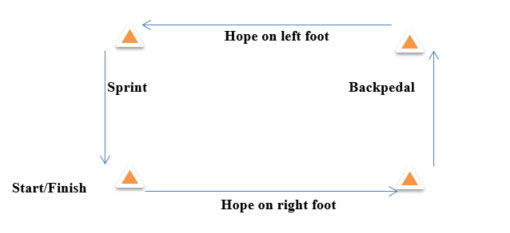
3 cone Turn Drill, Shuffle-Sprint-Backpedal:
Purpose: Improve, change of direction in cutting and turning.
Procedure: Place three cones 10 yards apart in a triangle pattern. Start in a two-point stance. Shuffle 5 yards and make a sharp right turn around the cone. Sprint to the second cone on the right and backpedal to the first cone. Repeat the exercise going in the opposite direction.
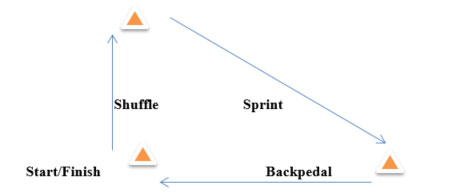
X-Pattern: 40-yard Sprint
Purpose: Improve lower body transitional movements and cutting.
Procedure: Place cones 10 yards apart in a square pattern. Start in a two-point stance. Begin on the left side of the square. Sprint to the second cone. Plant on the outside foot, and sprint diagonally to the third cone. Plant on the outside foot and backpedal to the third cone. At the third cone, plant on the outside foot and sprint diagonally to the fourth cone. Repeat the exercise going in the opposite direction.
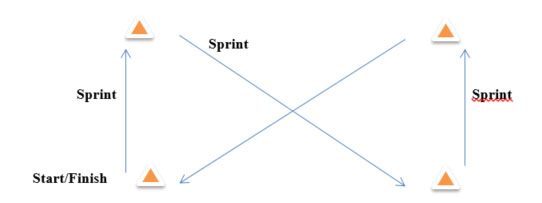
Pro-Agility: 20-yard line sprint, 5-10-5
Purpose: Improve the ability to change direction by enhancing footwork and reaction time.
Procedure: Place each cone 5 yards apart. Start in a two-point stance at the starting line, the center cone. Sprint to the end line and touch with your hand. Turn back and sprint to the far cone (10 yards) and touch the line. Turn back and sprint 5 yards through the start line to the finish.

30 Yard T-Drill:
Purpose: Improve the ability to change direction and increase conditioning.
Procedure: Start in a two-point stance at the starting line. Sprint forward 5 yards to the cone. Side shuttle to the right and touch the line 5 yards away with your right hand. Shuffle back to the left 10 yards and touch the far line with your left hand. Shuffle back to the right 5 yards to the center cone. Touch the spot with either foot and backpedal through the start line to the finish.
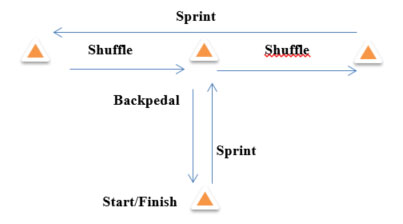
Dr. Mishock is one of only a few clinicians with doctorate-level degrees in both physical therapy and chiropractic in the state of Pennsylvania. Mishock Physical Therapy & Associates has seven convenient locations in Gilbertsville, Skippack, Phoenixville, Barto, Limerick, Pottstown, Steiner Medical. He is the owner of Train 2 Play Sports which provides scientifically based training materials to help athletes, coaches, parents, trainers, and healthcare providers to teach and create proper physical literacy and athleticism for improved sports performance and injury prevention. The program starts with basic movement patterns, progressing to advanced exercise and elite training techniques. He has also authored two books; “Fundamental Training Principles: Essential Knowledge for Building the Elite Athlete”, “ The Rubber Arm; Using Science to Increase Pitch Control, Improve Velocity, and Prevent Elbow and Shoulder Injury” both can be bought on Amazon.
References:
1. Sheppard JM et al. Agility literature review: Classification, training, and testing. J Sports Sci. 2006 Sep; 24(9):919-32.
2. Gabbett TJ et al. Speed, change of direction speed, and reactive ability of Rugby League Players. Journal of Strength and Conditioning Research, 2008, 22,174-181.
3. Sheppard JM et al. An evaluation of a new test of reactive agility and its relationship to sprint speed and change of direction speed, Journal of Science and Medicine in Sport, 2006, 9, 342-349.
4. Rhea MR, Oliverson JR, Marshall G, Peterson MD, Kenn JG, Ayllón FN, Noncompatibility of power and endurance training among college baseball players. J Strength Cond Res. 2008 Jan;22(1):230-4.
5. Mustafina L et al. AGTR2 gene polymorphism is associated with muscle fibre composition, athletic status and aerobic performance. August 1, 2014 Experimental Physiology, 99, 1042-1052.
6. Sperlich et al. studied 14-year-old soccer players performing a 5-week high-intensity sprint training program. The authors found significant changes in sprint performance while performing interval sprints at 60-75% maximal hear rate.
7. Simoneau JA,Bouchard C. Genetic determinism of fiber type proportion in human skeletal muscle.The FASEB Journal vol. 9 no. 11 1091-1095
8. Sperlich, B, De Marées, M, Koehler, K, Linville, J, Holmberg, H-C, and Mester, J. Effects of 5 weeks’ high-intensity interval training vs. volume training in 14-year-old soccer players. J Strength Cond Res 25(5): 1271-1278, 2011
9. Iaia, F, Fiorenza M, Perri Enrico et.al. The Effects of Two Speed Endurance Training Regimes on Performance of Soccer Players. 2015.Sep 22; 10(9). Journal Prone.
